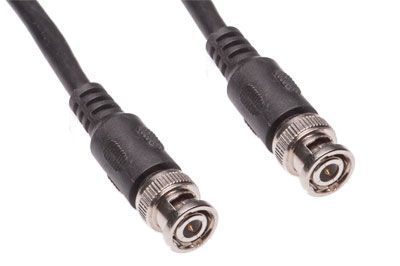RG59 BNC Patch Cable - Male/Male
RG59 BNC Coax Cable - 200FT BNC Male to Male RG59 Cable
These RG59 BNC cables are primarily used for radio antenna, CCTV, and other video applications. This RG59 BNC patch cable features a rugged design for tough environments as well as superior shielding to block RFI/EMI interference. RG59 has a thinner diameter than RG6 (0.242 inches vs. 0.332 inches). This decreased diameter means RG59 is less expensive to produce than RG6. Generally, RG6 is recommended for longer runs; however, for all lengths of BNC patch cables, there should be no difference in terms of performance.
Features:
- Length: 200 Foot
- Connector A: BNC Male
- Connector B: BNC Male
- Dual Shielded
- 22 AWG Copper covered steel Conductor
- RG59 Coaxial Cable
- 75 Ohm Impedance
- Fully Molded Connectors
- Diameter: 0.242 inches
Q: What does BNC stand for?
A: BNC stands for Bayonet Neill-Concelman. They are named after the bayonet locking mechanism and their inventors.
Q: What are BNC connectors commonly used for?
A: BNC connections are typically used on RF video and Ethernet applications.
Q: What does “RG IN mean?
A: The 'RG' is short for 'Radio Guide ' a term that dates back to the World War II era when the military made heavy use of coaxial cable and developed a set of standards to specify different grades of coax and their applications. Even though we still refer to coaxial cables by their original RG numbers today these standards are now obsolete in regard to actual military use.
Q: What is the difference between RG59 and RG6?
A: Each of these coaxial cables has a characteristic impedance of 75 ohms. RG59 cable has a smaller diameter center conductor than RG6 resulting in higher signal loss. RG59 cables are typically specified for use as equipment patch cords because of their smaller bend radius and enhanced flexibility. Since RG6 cables exhibit less attenuation than RG59 they are more commonly used for distributed cabling and are recommended for use up to 295 ft.
Q: What is the difference between 50 and 75 Ohm Cables?
A: 50 and 75 Ohm values refer to the impedance of the coaxial cable. Impedance is a measure of resistance in the cable to the flow of electrical energy. There really is no “good IN or “bad IN impedance just the right impedance for your application. For 75 Ohm cable the primary application is the transmission of a video signal. In the case of 50 Ohm cable it is a data signal that is for the most part being transmitted.
Q: What does AWG stand for?
A: AWG is the gauge size and denotes the thickness of the cable. The lower the gauge of the cable the thicker the cable will be. AWG stands for 'American Wire Gauge' and is a standardized wire gauge system used throughout the industry.
| Features & Specs | ||
|---|---|---|
| Cable Type | Thetype of cable described? | RG59 |
| Conductor Material | Thetype of material used in the conductor of thecable?? | Copper Clad Steel |
| Conductor Size | Gauge ofcenter conductor? | 22 AWG |
| Impedance | Impedanceof cable? | 75 ohms |
| Jacket Material | Thetype of material used in the jacket of the cable? | PVC |
| Cable Diameter | Diameterin inches of cable? | .242 inches |

